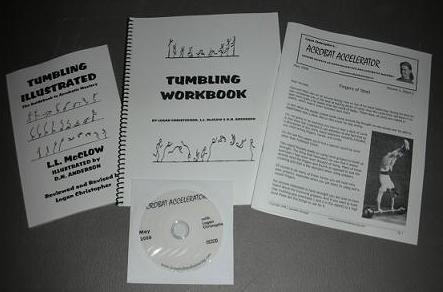The past couple days have been crazy. I was amazed at the response to the Tumbling Course. Within a few minutes of putting the page up orders were coming in.
The good news is if you’ve bought your copy of the Tumbling Course before today, it is in the mail and on its way.
For those of you who’ve ordered, could you do me a favor and send me a email when it does arrive, with your initial impressions? Thanks!
There are quite a few left so if you’ve been waiting now’s the time to act. When I was looking over the course I couldn’t help but to think what a good deal it is.
In order to actually show you I’ve added a picture of all that you’ll get to the Tumbling Course page, but you can see it right here.

And that doesn’t even include the bonus tele-seminar. Right now, you have 5 days left to get it at $49.
Those that have ordered will understand the following. Here is a list of the benefits of tumbling, an excerpt from Loken and Willoughby’s ‘Complete Book of Gymnastics’.
The specific values of tumbling activities are:
1. Tumbling develops coordination and timing.
2. Tumbling develops agility and flexibility because of the nature of the movements involved in the activity, Much bending, tucking, and twisting is required to perform the stunts well.
3. Because of the running and springing necessary in tumbling activities, strength is developed in the legs. This is somewhat unique in that most other gymnastic activities tend to neglect the legs.
4.Courage and determination are developed in some of the more daring and difficult tumbling stunts. More advanced stunts involve movements performed with the body completely in the air.
5. Learning to control the body in basic tumbling skills has great carryover to the other sports.
6. The art of falling correctly, as learned in tumbling, is of great importance in many sports as well as normal daily activities. A relaxed rolling fall very often prevents or reduces injury and enable a person to regain his feet quickly after a fall.
7. Because tumbling is a natural activity, it is self-motivating and provides a great deal of fun and enjoyment for its participants.
Very well said, and succinctly too. As complete as list as there could be. If you want to get started quickly you know where to go, https://lostartofhandbalancing.com/tumbling.html
Good Luck and Good Tumbling,
Logan Christopher
P.S. I’ll be sharing with you some old hand balancing pictures this weekend that you haven’t seen before.









